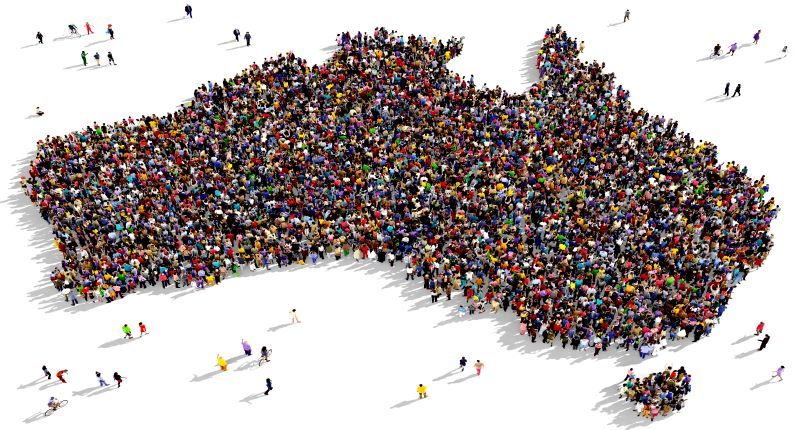- Net overseas migration was - 85,000 in 2020-21
- With net overseas migration expected to reach 235,000, annual population growth is expected to be around 365,000 for the foreseeable future
- This is expected to further exacerbated the rental market nationally
Despite a lengthy period of closed international borders, Australia’s population has continued to grow. Although Australia has a low fertility rate of 1.58 births per woman, from 3.54 in 1961, migration and one of the highest life expectancies in the world has facilitated this growth.
While net overseas migration was negative during 2020-21, at 85,000, this quickly rebounded to 150,000 during 2021-22. Given that the permanent migration cap is set to lift to 195,000, net overseas migration is expected to reach 235,000 yearly for the foreseeable future.
After adding natural population growth, it is expected Australia’s population will rise by 365,000 annually.
BuyerBuyers cofounder Pete Wargent noted that population growth has not been much in the news of late, despite the population recently reaching 26 million – a million more than what most people would assume.
“It’s often overlooked that with Australia’s strong population pyramid and life expectancy generally increasing, the population tends to grow naturally by around ½ per cent per annum, with births comfortably exceeding deaths,” said Mr Wargent.
“Now for the first time in a decade we have full employment and a genuine skills shortage, and after a hiatus, we should expect a strong rebound in net overseas migration.
Pete Wargent, BuyersBuyers

“Indeed, with the permanent migration cap lifted to 195,000 per annum, the Budget papers assume net overseas migration of 235,000 per annum going forward. And history suggests that we tend to underestimate population growth in Australia.”
Net overseas migration Australia, actual and projected
| 2020-21 | 2021-22 | 2022-23 | 2023-24 | 2024-25 | 2025-26 |
| -85,000 | 150,000 | 235,000 | 235,000 | 235,000 | 235,000 |
Source – Australian Treasury
Population by state and territory, actual and projected
| NSW | VIC | QLD | WA | SA | TAS | ACT | NT | TOTAL (a) | Australia | |
| 2020-21 | 8,094 | 6,548 | 5,218 | 2,750 | 1,803 | 0.568 | 0.454 | 0.249 | 25,683 | 25,688 |
| 2021-22 | 8,149 | 6,614 | 5,302 | 2,780 | 1,822 | 0.575 | 0.460 | 0.255 | 25,956 | 25,961 |
| 2022-23 | 8,228 | 6,720 | 5,390 | 2,824 | 1,845 | 0.582 | 0.467 | 0.258 | 26,313 | 26,318 |
| 2023-24 | 2,319 | 6,841 | 5,467 | 2,866 | 1,865 | 0.588 | 0.474 | .262 | 26,682 | 26,687 |
| 2024-25 | 8,412 | 6,959 | 5,545 | 2,908 | 1,883 | 0.595 | 0.483 | 0.265 | 27,050 | 27,055 |
| 2025-26 | 8,504 | 7,077 | 5,623 | 2,949 | 1901 | 0.601 | 0.492 | 0.268 | 27,416 | 27,421 |
Source – Australian Treasury
Notably, Victoria’s population is expected to reach 7 million by 2026, with Western Australia’s population forecast to be just shy of 3 million by then, and 2 million in South Australia.
What will happen to the housing market by 2030?
BuyersBuyers CEO Doron Peleg noted that property market participants are well aware of demographics dynamics and factor this into buying and selling decisions.
He also noted that many talking heads and media commentators assumed the housing market would plunge in 2020 and 2021 given the lack of immigration. This is an example of first-order thinking and ultimately was not proven to be the case.
“Most Aussies understood that the borders would reopen in time, and many took advantage of lower interest rates to buy through the pandemic period,” he said.
“Looking further ahead, in the absence of a deep recession it’s likely that we’ll see a very strong rebound in population growth.
“At face value, the drop in borrowing capacity since 2021 might imply a drop of 20 to 30 per cent in housing prices.
“In reality, professional incomes are now rising strongly in nominal terms, asking rents are rising by 20 per cent per annum, and there’s stamp duty tax reform in the table in New South Wales.”
Doron Peleg, BuyersBuyers
“And most participants in the market can see that, unlike in some previous market downturns, we’re heading for a chronic shortage of well-located housing.”
Visa processing increasing
The rebound of population growth in Australia is likely to be a much-needed respite for the local labour market, which is under severe stress.
“The government is dedicating funding and energy towards accelerating visa processing times to clear the backlog and bring the labour supply back into balance,” Mr Wargent added.
“On a net basis we can expect 1 million arrivals over the next four years, and overwhelmingly they will add to the tenant pool, at least initially.
Mr Wargent that at some point, it must become easier for landlords to borrow to supply the new rental stock that’s needed.
“Lending assessment buffers are too stringent at the moment at 300 basis points, so it’s no surprise that rental vacancy rates are at all-time lows and tightening,” he said.
“The big picture is that most prospective buyers can foresee that the Australian population is likely to increase from 26 million to 29 million by the end of the end of 2030”.
“So while there’s always a fear of overpaying in a falling market, the potential demand from buyers is like a coiled spring. There’s a huge amount of pent-up equity and demand on the sidelines looking to get into the market in due course.”








